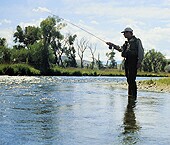
TUESDAY, April 2 (HealthDay News) — Antihistamines and other medicines disrupt the ecosystems of streams, a new study finds.
“Pharmaceutical pollution is now detected in waters throughout the world,” lead author Emma Rosi-Marshall, a scientist at the Cary Institute of Ecosystem Studies in Millbrook, N.Y., said in an institute news release. “Causes include aging infrastructure, sewage overflows and agricultural runoff. Even when wastewater makes it to sewage treatment facilities, they aren’t equipped to remove pharmaceuticals.”
“As a result, our streams and rivers are exposed to a cocktail of synthetic compounds, from stimulants and antibiotics to analgesics and antihistamines,” Rosi-Marshall said.
The researchers examined how some common medicines affect similar-sized streams in New York, Maryland and Indiana. The medicines included the antibiotic ciprofloxacin, the diabetes drug metformin, two antihistamines used to treat heartburn (cimetidine and ranitidine) and an antihistamine used to treat allergies (diphenhydramine).
“We focused on the response of biofilms — which most people know as the slippery coating on stream rocks — because they’re vital to stream health,” Rosi-Marshall said. “In streams, biofilms contribute to water quality by recycling nutrients and organic matter. They’re also a major food source for invertebrates that, in turn, feed larger animals like fish.”
The antihistamine diphenhydramine (Benadryl is one brand) caused significant disruption to biofilm communities in the streams, according to the study appearing in the journal Ecological Applications.
“[Diphenhydramine’s] effect on biofilms could have repercussions for animals in stream food webs, like insects and fish,” Rosi-Marshall said.
The other medicines in the study also had measurable effects on the biofilm communities in the streams. The findings highlight the ecological threat posed by pharmaceutical waste and the need for more research into this issue, the study authors said.
More information
The U.S. Environmental Protection Agency has more about pharmaceuticals and personal-care products in the environment.

